Recent Articles
Popular Makes
Body Types
2016 Infiniti Q50 Road Test and Review
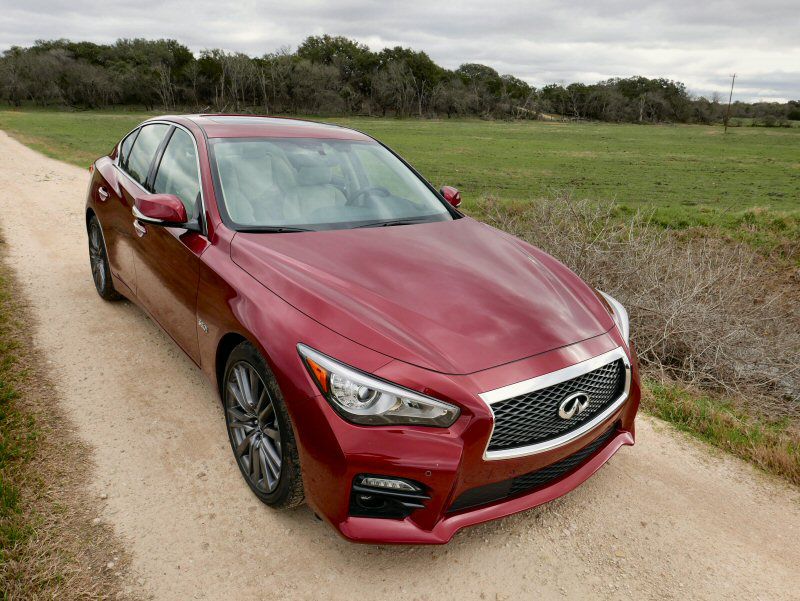
2016 Infiniti Q50 Red Sport 400 Front 3 Quarter 07 ・ Photo by Benjamin Hunting
When the Infiniti Q50 appeared on the scene a few short years ago, its redesigned bodywork was paired with a list of familiar drivetrains that linked the car back to its early days as the G sedan. The 2016 Infiniti Q50 completes the refresh by finally installing all-new engines under the hood, alongside a host of advanced driving technologies that continue to separate the four-door luxury car's character from the rest of the competition. Whether you will find these digital details intriguing or yearn for fewer layers between the driver's seat and the road beneath your wheels is largely a matter of personal taste. Still, Infiniti has chosen a very specific path when pushing forward with the Q50 sedan, and the 2016 version of the car represents the most carefully-executed iteration of the brand's philosophy to date.
New Entry-Level Turbo
It used to be that the entry-level version of the Infiniti Q50 was actually the previous-generation model of the car, sold alongside the new model as the Q40 at a more affordable price until just last year. An unusual strategy, to say the least - and one that has now been relegated to the past by the introduction of a new 2.0-liter turbocharged four-cylinder version of the car. Capable of producing 208 horsepower and 258 lb-ft of torque, Infiniti representatives told me that models featuring this motor are intended to compete against the base BMW 320i, a less-endowed version of the German automaker's own 2.0-liter turbo, but surprisingly made no mention of the 240-horsepower 328i, which is BMW's volume seller. The Infiniti engine is itself the product of a partnership with one of the luxury world's other Teutonic stalwarts, Mercedes-Benz, although it is built in Tennessee by corporate parent Nissan's home team.
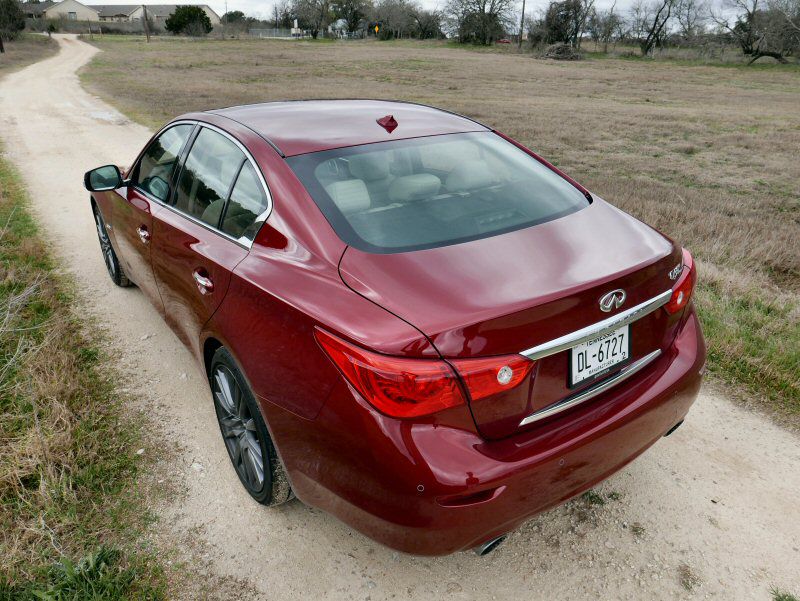
Photo by Benjamin Hunting
Bye-Bye VQ V-6
Longtime Infiniti fans will take note that the 2016 Infiniti Q50 is the first version of that car - and, indeed, the first version of any luxury sedan from the brand - to not be offered with a gas-only version of the venerable VQ-series V-6. In place of last year's 3.7-liter unit is a down-sized six-cylinder known as the VR, which squeezes as much as 400 horsepower and 350 lb-ft of torque out of its 3.0 liters of displacement by way of a single turbocharger. There's also a 300-horsepower edition of the same engine available in mid-tier models of the Q50, in effect giving Infiniti a pair of sedans that sit just below and far above the existing crop of premium rivals in terms of power. As with the 2.0-liter, a seven-speed automatic transmission is the only gearbox available with the car, although V-6 editions add the wrinkle of optional all-wheel drive.
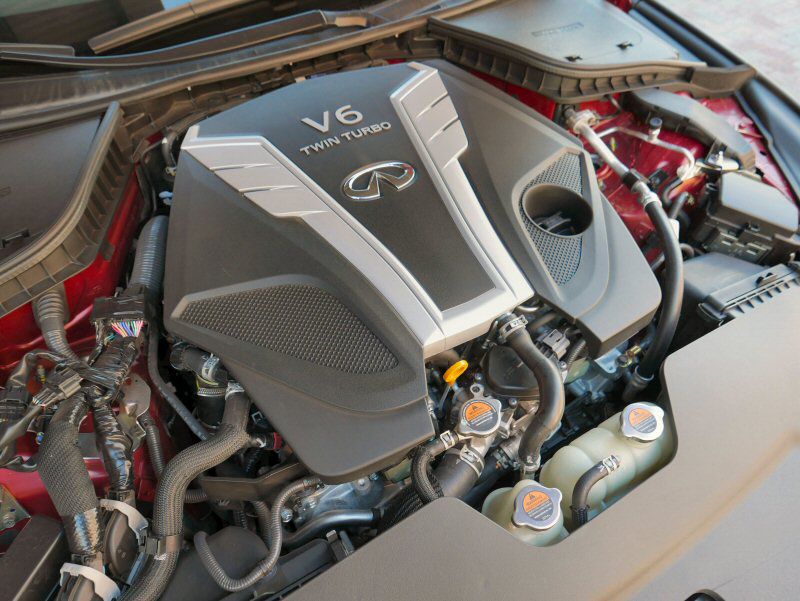
Hybrid Still In the Cards
Infiniti has never been particularly known for its hybrid technology, but it does continue to offer electrically-assisted drivetrains across several different platforms. The 2016 Infiniti Q50 Hybrid features the only carry-over engine setup in the Q50 family, an older version of the VQ V-6 in 3.5-liter form that together with its electric motor is good for 360 total system horsepower. Fuel mileage for the Q50 is listed at 28 mpg in city driving and 34 mpg on the highway - not exactly sparkling numbers for a car its size, particularly one featuring a hybrid design. The numbers drop to 27 mpg around town and 31 mpg highway if you snag an all-wheel drive edition of the vehicle. Infiniti has yet to publish EPA estimates for the rest of the Q50 line-up, but it's a safe assumption that none will trump the Hybrid, at least in city mileage.

Electric Power Steering Redux
The Infiniti Q50 was the first production model to offer a completely computerized steering system to the general public (albeit one with a mechanical failsafe ready to spring into action should the electronic controller ever fail). For 2016, that system has been further honed in order to improve the overall experience behind the wheel. The steer-by-wire design is offered on the turbocharged V-6 as well as the Hybrid models of the new Q50, with the entry-level four-cylinder making do with a less-configurable electrically-assisted hydraulic design. Infiniti engineers stressed that the goal in producing this latest iteration of Direct Adaptive Steering was to improve the level of feedback provided to pilots through the wheel. Out in the real world, there appeared to be somewhat of a contradiction in the actual delivery of this aimed-for connection with the road. While it's true that the system allows for drivers to configure things such as resistance and response in order to personalize the car's character, it has also been designed to filter out certain types of feedback that Infiniti considers detrimental to driving. Specifically, if you were to travel over an uneven speed bump or a pothole in a Q50 equipped with Direct Adaptive Steering, the wheel would not move in your hands even if the impact was enough to deflect the suspension. It's here that the ones and zeros behind the scenes of Infiniti's luxury sedan design begin to reveal themselves, with all feedback being carefully filtered through a pre-determined set of criteria before allowing for interpretation by the driver. Yes, there's a definite difference in "feel" between the standard steering settings and the sportier ones (alternatively labeled Sport+ and Dynamic+), but overall it's still a curated experience that's quite unlike what you'd find in the Mercedes-Benz C-Class or Audi A4.
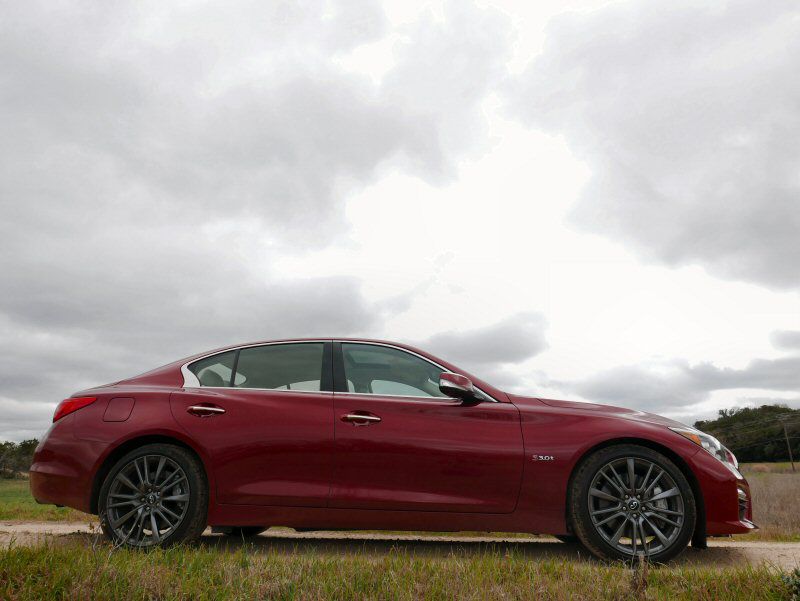
Photo by Benjamin Hunting
Revised Chassis and New Adaptive Suspension Smooth Out Ride
Other aspects of the 2016 Infiniti Q60's software-oriented fare better in conveying the moment. The 2016 sedan gains its first adaptive dampers, which are linked to the car's drive mode selector switch on the center console. Toggling between the vehicle's various modes not only swaps in different steering parameters as discussed above, but it also stiffens up the vehicle's Dynamic Digital Suspension when set to either Sport or Sport+. Catching the adaptive wave is an important step for Infiniti in matching the technological exploits of most other premium sedans in its class, and it's fair to say that when set to Sport+ the Q50 does offer less roll when cornering in trade for a slight decrease in ride comfort. No doubt the vehicle's redesigned sway bars and new rear suspension configuration also play a role in planting the vehicle on the tarmac. It's not night and day when you flip the switch from soft to firm in the Q50, but the difference is there for those looking step a little closer to the edge on a Friday evening commute.
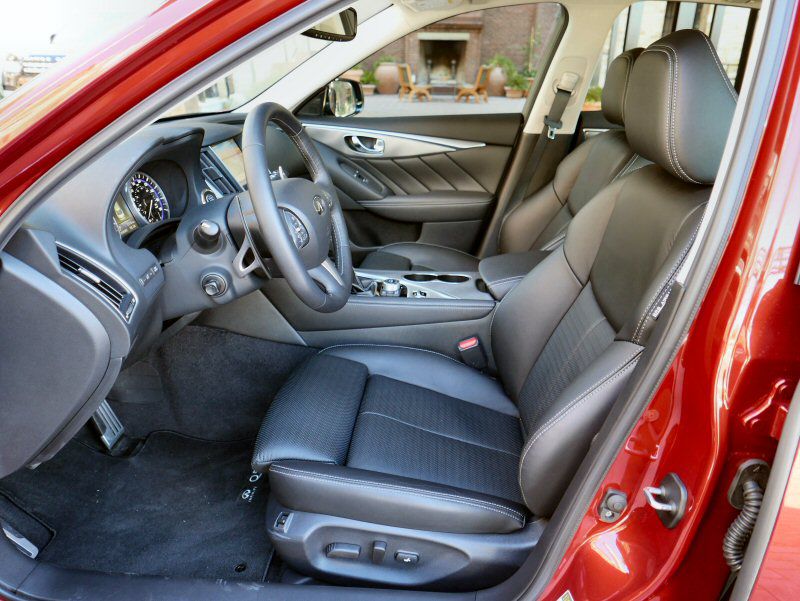
Photo by Benjamin Hunting
Safety Tech Continues to Reign Supreme
A big part of Infiniti's drive-by-wire steering design has to do with its emphasis on advanced safety technology. By offering full computerized control over the front wheels, the 2016 Infiniti Q50's lane departure prevention and blind spot intervention systems are that much more capable when it comes to keeping the sedan between the lines and out of harm's way. The car's suite of safety gear is impressive: there's also lane departure and blind spot warning, an automatic braking feature that works when reversing, and a "predictive" collision warning and mitigation system that is programmed to observe as far as two vehicles ahead to determine whether the Q50 might need to slam on its brakes. Thanks to the chaos that is Texas interstate traffic, I was able to sample several of these features during my time driving the 2016 Infiniti Q50, and I can confirm that they work as advertised. I can also testify that having your car beep at you every few minutes as you stray over the line on a rural two-lane road is extremely irritating. Fortunately, you can turn off, or at the very least dial down, the Q50's various nannies as desired.
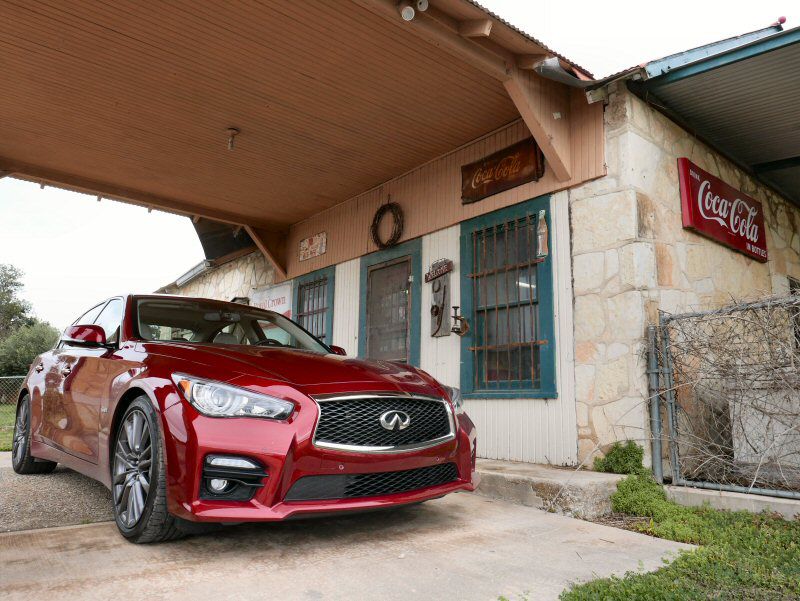
Photo by Benjamin Hunting
A Very Quick Daily Driver
It's still early in the game for Infiniti, which meant that the only version of the 2016 Q50 that was available for me to drive at its San Antonio launch was the Red Sport 400, featuring the most powerful version of the car's turbocharged V-6. Even in pre-production trim, it's hard not to be impressed with just how eloquently Infiniti has combined fast and smooth with this particular drivetrain. Off of the line, there's minimal wheel spin even if you mash the throttle, while at speed the difference between 65 mph and 120 mph evaporates in mere seconds. Most deceptive is the lack of any sensation from the car that you're traveling at a rate that would have a similarly dissolving effect on your license should you attempt them on public roads instead of a closed course. The speed is just 'there,' appearing under your nose like five days' mustache growth after a road trip, and there were times that I had trouble believing the speedometer readout given how calm and composed the car felt at the indicated velocity.
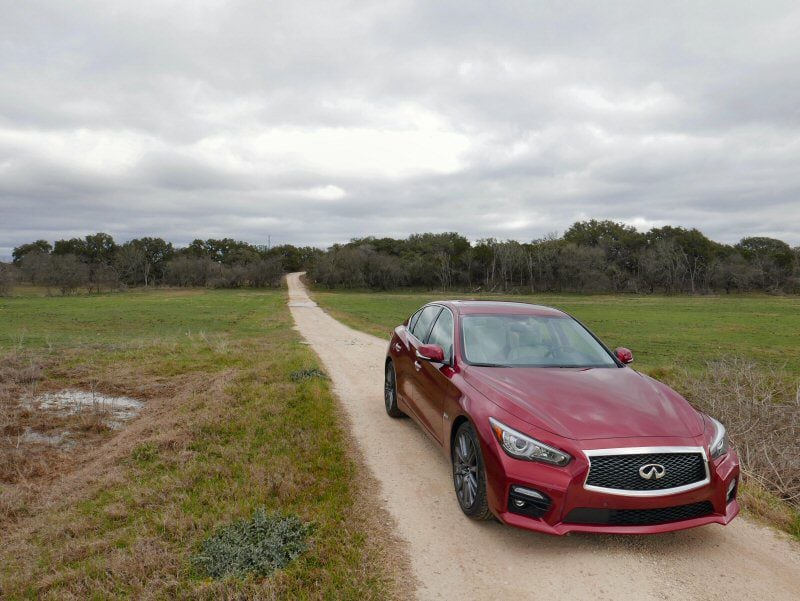
Photo by Benjamin Hunting
Red Sport Not Quite a Serious Performance Sedan Threat
The 2016 Infiniti Q50 Red Sport 400 is definitely quick, and certainly easy on the eyes. One thing it's not, however, is a legitimate threat to the established sport sedan hegemony. That digital filtering that I mentioned earlier when discussing the Q50's steering system also rears its head when you try to get frisky with the car in a performance environment, such as on the small autocross course Infiniti laid out to demonstrate various aspects of the sedan's dynamics. You see, it's impossible to fully disable the Q50's stability control system, which means you've got to try to drive within the invisible boundaries it has created around you to avoid throttle intervention or unwanted braking. Combine that with the one-step-removed feedback of the vehicle's steering, as well as its somewhat-soft suspension settings (even when in Sport+), and you end up with a competent luxury car that's unfortunately incapable of shining brighter than the competition anywhere other than in a straight line. How much this matters to you is again dependent on your perspective. Vehicles like the C-Class and the A4 illustrate that there's a strong market for luxury cars that don't put absolute performance on a pedestal, and it's always reassuring to see a brand refusing to step to the tune called out by BMW with its class-dominating 3 Series. Still, to offer such a powerful model and give it the evocative Red Sport name without removing at least one or two of the training wheels feels like a missed opportunity for Infiniti.
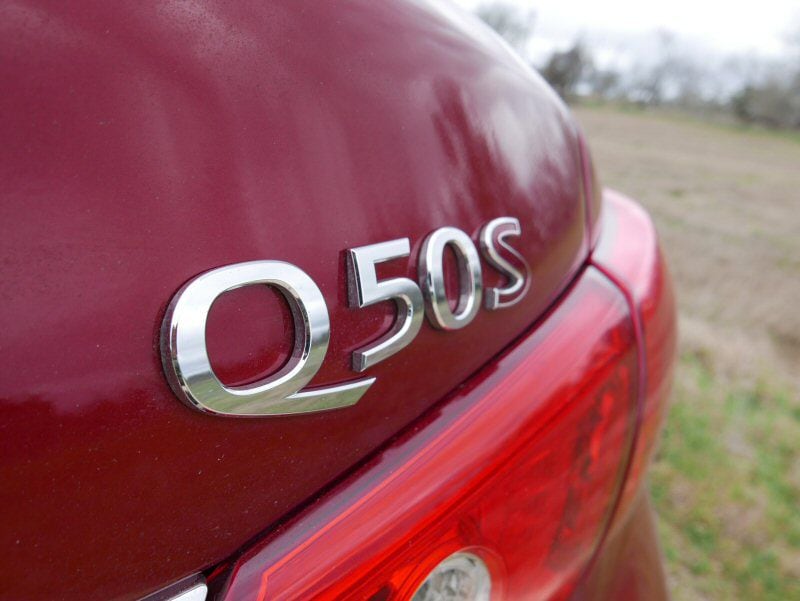
Photo by Benjamin Hunting
2016 Infiniti Q50 Pros/Cons
Pros: • Stylish design • Broad model range ensures affordability (roughly $30k-$55k pricing structure) • Extremely quick in Red Sport 400 trim • Excellent active safety gear • Comfortable rear seat • Smooth ride • Available all-wheel drive Cons: • Not as nimble a handler as several of its rivals • Invasive stability control cannot be disabled • Steering feels artificial at times • Hybrid model not all that fuel efficient

Photo by Benjamin Hunting